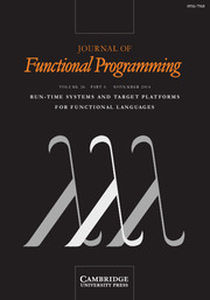Parallel functional programming on recursively defined data via data-parallel recursion
Published online by Cambridge University Press: 01 July 1999
Abstract
This article proposes a new language mechanism for data-parallel processing of dynamically allocated recursively defined data. Different from the conventional array-based data-parallelism, it allows parallel processing of general recursively defined data such as lists or trees in a functional way. This is achieved by representing a recursively defined datum as a system of equations, and defining new language constructs for parallel transformation of a system of equations. By integrating them with a higher-order functional language, we obtain a functional programming language suitable for describing data-parallel algorithms on recursively defined data in a declarative way. The language has an ML style polymorphic type system and a type sound operational semantics that uniformly integrates the parallel evaluation mechanism with the semantics of a typed functional language. We also show the intended parallel execution model behind the formal semantics, assuming an idealized distributed memory multicomputer.
Information
- Type
- Research Article
- Information
- Copyright
- © 1999 Cambridge University Press
Footnotes
- 7
- Cited by


Discussions
No Discussions have been published for this article.